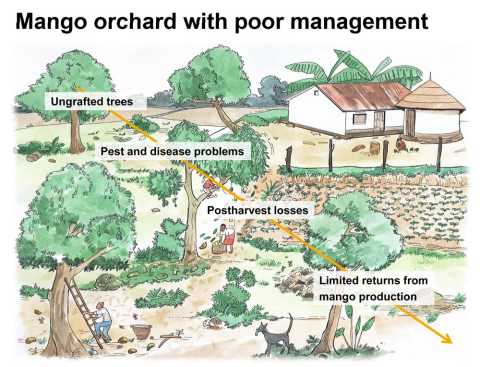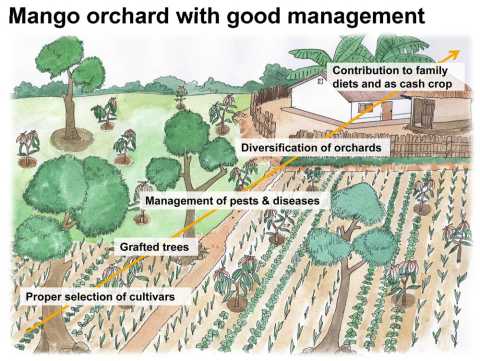Introduction

Mango trees (Mangifera indica L.) are cultivated in many countries of East, South and West Africa. In these countries, mangoes contribute to farmer family diets as well as serving as a cash crop. Mangoes are a delicate fruit and, therefore, sensitive to transport, which limits trade opportunities. However, there is considerable market interest in processed mango—in pulp or dried form.
Common challenges to mango production in Africa

Many farmers in Africa invest in mango orchards. However, there are a number of production-related hindrances at farm level, including:
- Limited access to good quality planting materials - There is a general shortage of grafted planting materials of improved and higher yielding varieties in many areas. Farmers often use inferior seedlings obtained by germinating mango seeds from indigenous varieties. Such ungrafted trees take much longer to bear fruit. Whereas grafted trees begin to bear fruit within 3 to 4 years, ungrafted trees will take at least 5 years to bear fruit, depending on the growing conditions.
- Pest and disease problems - Mangoes have many devastating pests and diseases, which can result in total yield loss. Major pests include the fruit fly (Bactrocera invadens), seed weevil (Sternochetus mangiferae) and mealy bugs (Rastrococcus invadens). Diseases like anthracnose and powdery mildew are common in almost all mango growing areas.
- Poor orchard management - In many areas, mango trees are left to grow so big that pest and disease management, harvesting and other field operations are difficult to implement. Except in big or commercial farms, mango trees are normally scattered around the gardens, ranging from 2 to 100 trees per household. This scattered nature makes mango a commonly neglected crop in terms of management, but becomes important only during the harvesting season.
- Postharvest losses - Fruit damage is a common problem as a result of poor pest and disease management and the poor harvesting practices. Also, a lot of fruit is lost after harvest, especially during the peak seasons due to the limited capacity to store and process fruit. This is further worsened by the poor roads and transport infrastructure to markets.
- Limited returns from mango production - Mango is highly seasonal and harvest is only expected at certain times of the year depending on the local conditions. During this time, most areas are harvesting and so the local markets are saturated and, therefore, offer very low prices, which may not even cover transportation costs.
Mango production is becoming a very important economic activity with potential to improve food and income security. Strategies are, therefore, needed to minimize risks associated with mango production and improve the productivity of mango orchards. This guide, therefore, introduces approaches that can contribute to better production conditions of mangoes, and can be adapted to the prevailing local conditions.

Comments
Post a Comment